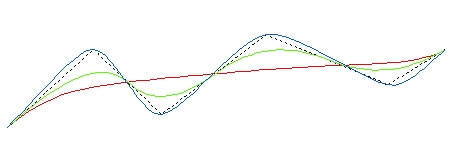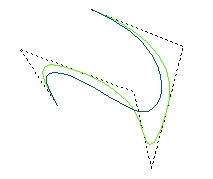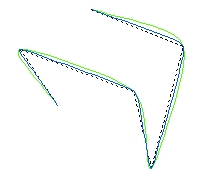
Smooth the features of a polyline layer using three different smoothing algorithms
Smooth results: Dashed - Original; Red - Bezier; Green - B-Spline; Blue- T-Spline (Default parameters)

Bezier

B-Spline

T-Spline

Parameters
| Expression | Explanation |
|---|---|
| Function Name | SmoothBezier |
| Function Name | SmoothBSpline |
| Function Name | SmoothTSpline |
| <input dataset> | A String representing the input layer. Must be of Polyline type. |
| <output dataset> | A String - the full name of the output layer. |
| <Smoothness> | An Integer that defines the number of points in the output curve. The allowed values ( 2 to 20 )
in fact are point multiplier. The number of vertices of the original polyline multiplied by this value
will give the number of vertices of the smoothed polyline. The larger the value of the |
| <Freedom> | Only for B-Spline. An Integer that defines how close to the original polyline the curve will be. The allowed values are from 3 to 10. Smaller values give better approximation. With large values the curve will become very similar to Bezier curve |
| <Tension> | Only for T-Spline. An Integer that defines how close to the original polyline the curve will be. Increasing the tension is similar to pulling on the ends of a string constrained to pass through the polyline vertices. allowed values are from 1 to 100. |
| {Densify Before} | A Double representing the Densification tolerance. In some cases the smooth parameters cannot restrict the smoothing enough. The user can restrict the effect of the smoothing by introducing new vertices in the shapes. See Densify function for details |
| {Generalize After} | A Double representing the Generalization tolerance. The smoothing introduces in the shapes many new vertices. The user can decrease the number of vertices by using this option. See Generalize function for details. |
ETGWPath used in the table below is the full path to ETGWRun.exe (E.G. "C:\Program Files\ETSpatial Techniques\ETGeo Wizards\ETGWRun.exe")
| Language | Syntax |
|---|---|
| Python | subprocess.call([ETGWPath, "SmoothBezier", "input dataset", "output dataset", "Smoothness", "Densify Before", "Generalize After"]) |
| .NET using ETGWRun.exe | StartInfo.FileName = ETGWPath StartInfo.Arguments = "SmoothBezier" "input dataset" "output dataset" "Smoothness" "Densify Before" "Generalize After" |
| .NET using ETGWOutX.dll | SmoothBezier(input dataset, output dataset, Smoothness, Densify Before, Generalize After) |
| ArcPy | arcpy.SmoothBezier(input dataset, output dataset, "Smoothness" , "Densify Before", "Generalize After") |
| Language | Syntax |
|---|---|
| Python | subprocess.call([ETGWPath, "SmoothBSpline", "input dataset", "output dataset", "Smoothness", "Freedom", "Densify Before", "Generalize After"]) |
| .NET using ETGWRun.exe | StartInfo.FileName = ETGWPath StartInfo.Arguments = "SmoothBSpline" "input dataset" "output dataset" "Smoothness" "Freedom" "Densify Before" "Generalize After" |
| .NET using ETGWOutX.dll | SmoothBSpline(input dataset, output dataset, Smoothness, Freedom, Densify Before, Generalize After) |
| ArcPy | arcpy.SmoothBSpline(input dataset, output dataset, "Smoothness" , "Freedom", "Densify Before", "Generalize After") |
| Language | Syntax |
|---|---|
| Python | subprocess.call([ETGWPath, "SmoothTSpline", "input dataset", "output dataset", "Smoothness", "Tension", "Densify Before", "Generalize After"]) |
| .NET using ETGWRun.exe | StartInfo.FileName = ETGWPath StartInfo.Arguments = "SmoothTSpline" "input dataset" "output dataset" "Smoothness" "Tension" "Densify Before" "Generalize After" |
| .NET using ETGWOutX.dll | SmoothTSpline(input dataset, output dataset, Smoothness, Tension, Densify Before, Generalize After) |
| ArcPy | arcpy.SmoothTSpline(input dataset, output dataset, "Smoothness" , "Tension", "Densify Before", "Generalize After") |
Notes:
<> - required parameter
{} - optional parameter
The argument separator for StartInfo.Arguments is space. If a string might contain a space, you need to double quote it.